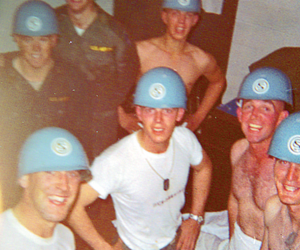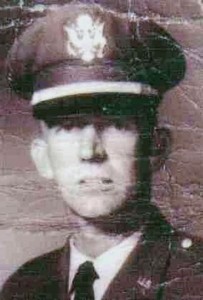
The next time you are in Ringsend, stop and have a look at the barber’s shop that faces the front doors of St Patrick’s Church. It used to be Cecil’s barber shop and I am sure it will bring back some very happy memories, as it did for me, to all those who had their hair cut by either Cecil or Jimmy Driver.
I remember the chairs they had in Cecil’s were like big dentist’s chairs. So big, in fact, that when you were a young boy and you were called up next, Cecil or Jimmy would put a piece of wood resting on the arms of the chair and then invite you to sit on the piece of wood. Climbing up that chair was like making an assault on Mount Everest; you suddenly became the tallest person in the world!
When I was in the shop there was always one thing that would catch my eye and that was the medal hanging on the wall. It was the Purple Heart award, and the soldier who was awarded it was a man called John Cecil Driver.
John Driver was a professional soldier in every sense of the word. He joined the British Army when he was 17, and made the rank of Sergeant. He was selected and came through the very hard training programme for the Special Forces, taking part in the Rhodesian Civil War and the Malayan Emergency, and went on to serve in a number of other places, such as Aden and Cyprus.

So, when John joined the U.S. Army at 27, he had seen plenty of action already. He was with the 1st Air Cavalry Division, known as the Gary Owen, who went into a war zone by helicopter. The 1st Air Cavalry division were the heirs to General Custer of the Little Big Horn 7th Cavalry. There was also a Hollywood movie, We Were Soldiers, based on them. General Hal Moore, portrayed by Mel Gibson in the movie, described John Driver as a legend in the world of combat soldiers.
John progressed through the ranks and finally made the breakthrough into Officer Candidate School, reaching the rank of 1st Lieutenant.
During the Vietnam War, when John was on his first tour of duty, he went down into the Cu Chi Tunnels, where he lowered himself into a tiny shaft and then had to crawl along the inside of the tunnel in total darkness, not knowing what was ahead. John would go down into the tunnels and call out, in a rather domestic fashion, “Hello, anybody home?”
The tunnels of the Cu Chi were the base of the Military Region Committee Saigon-Gia Dinh High Command of the Cu Chi District Party Committee. These tunnels were a very sophisticated system underground, having hospitals and even kitchens built within.
In April 1969, John was on his second tour of duty in Vietnam, having just returned from leave. This was to be the last action he would see, sadly. John was in a region called Thua Thien at the time.
I suppose the best way to hear of what happened on that day would be from Mitchell “Mike” (Doc) Edwards, a contemporary and comrade of John:
“I was a medic with Bravo Company and was with Lt. Driver just before he died. He and I were sitting, leaning against opposing trees reading letters from home. He was telling me about his family and how much he missed them.
We were having a very personal moment talking about our families. John was a very likeable, capable leader. I didn’t get to know him very long as I had just transferred in from Echo Company a few days before. However, in that short time I grew to respect him as a leader and as a very kind man.
When the explosion of the claymore went off, he grabbed his M-16 and was off down the hill in a flash. I grabbed my aid bag and started down the hill after him. At that moment, another soldier and I were pinned behind a large tree with AK bullets whizzing by, kicking up dirt and tearing bark from the tree. After a few seconds it let up, and about that time 1st Sgt, hollered, ‘Doc, help, LT’s been hit.’ Just a few feet away, it broke my heart to see Lt. Driver had been hit in the head, and that he was dying.
1st. Sgt was a tough man, but he was crying and pleading for me to help Driver. It was the hardest thing I could do to tell 1st. Sgt that there wasn’t anything that could be done. He told me to go tend to the other wounded, as three others had been hit. I’ve always had regrets that I didn’t get to finish hearing the stories of the Lt’s family. He obviously loved them very much, as he was emotional as he spoke of them. Please let the family know the last thing on his mind before he died was of his family. This has affected me greatly over the years; I had just lost Lt.
Bruce King a few days before in Echo Company, and Lt. John Walsh, Lt. Driver’s replacement, was killed just a few days later in the same general area. I have not thought of these events in years, but my son is currently serving his second tour in Iraq, and all of these memories have come flooding back. I will carry these memories of these great men for the rest of my life, as I am sure their lives have shaped mine in some small way. God Bless All of Them.”
John is buried at Willamette National Cemetery in Portland Oregon, and is honoured on 27W, Row 99 of the Vietnam Veterans Memorial.
Main photo is from Veterans Wall of Faces website, supplied by Phil Dean and was taken on the night these men became Senior Candidates in late 1967. 53rd Company, 5th Student Battalion. John, circled, is second from right in the front row.
By Jimmy Dent

